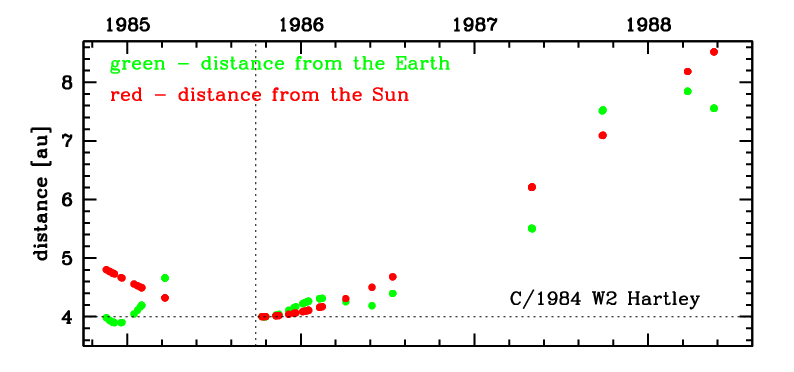C/1984 W2 Hartley
more info
Comet C/1984 W2 was discovered by Malcolm Hartley (1.2-m Schmidt telescope at Siding Spring) on 17 November 1984 (IAUC 4015), more than ten months before its perihelion passage. The comet was last seen on 18 May 1988.
The comet made its closest approach to the Earth on 11 December 1984 (3.89 au), that was three weeks after its discovery; in the next opposition the comet has closest approach to the Earth within 4.00 au (on 19 October 1985).
Solutions given here are based on data spanning over 3.50 yr in a range of heliocentric distances: 4.80 au – 4.00 au (perihelion) – 8.52 au.
This Oort spike comet suffers slight planetary perturbations during its passage through the planetary system but these perturbations can lead to escape of the comet from the solar system.
See also Królikowska 2014 and Królikowska and Dybczyński 2017.
The comet made its closest approach to the Earth on 11 December 1984 (3.89 au), that was three weeks after its discovery; in the next opposition the comet has closest approach to the Earth within 4.00 au (on 19 October 1985).
Solutions given here are based on data spanning over 3.50 yr in a range of heliocentric distances: 4.80 au – 4.00 au (perihelion) – 8.52 au.
This Oort spike comet suffers slight planetary perturbations during its passage through the planetary system but these perturbations can lead to escape of the comet from the solar system.
See also Królikowska 2014 and Królikowska and Dybczyński 2017.
| solution description | ||
|---|---|---|
| number of observations | 54 | |
| data interval | 1984 11 17 – 1988 05 18 | |
| data type | perihelion within the observation arc (FULL) | |
| data arc selection | entire data set (STD) | |
| range of heliocentric distances | 4.8 au – 4.00 au (perihelion) – 8.52 au | |
| type of model of motion | NS - non-gravitational orbits for standard g(r) | |
| data weighting | NO | |
| number of residuals | 107 | |
| RMS [arcseconds] | 1.87 | |
| orbit quality class | 1a | |
| previous orbit statistics, both Galactic and stellar perturbations were taken into account | ||
|---|---|---|
| no. of returning VCs in the swarm | 2873 | * |
| no. of escaping VCs in the swarm | 2128 | |
| no. of hyperbolas among escaping VCs in the swarm | 163 | |
| previous reciprocal semi-major axis [10-6 au-1] | 5.46 – 17.70 – 30.09 | |
| previous perihelion distance [au] | 430 – 490 – 560 | R |
| previous aphelion distance [103 au] | 65 – 110 – 290 | |
| time interval to previous perihelion [Myr] | 5.4 – 8.9 – 13 | R |
| percentage of VCs with qprev > 20 | 100 | |
| previous_g orbit statistics, here only the Galactic tide has been included | ||
|---|---|---|
| no. of returning VCs in the swarm | 3500 | * |
| no. of escaping VCs in the swarm | 1501 | |
| no. of hyperbolas among escaping VCs in the swarm | 41 | |
| previous reciprocal semi-major axis [10-6 au-1] | 10.05 – 20.83 – 31.38 | |
| previous perihelion distance [au] | 14 – 94 – 600 | R |
| previous aphelion distance [103 au] | 64 – 96 – 190 | |
| time interval to previous perihelion [Myr] | 5.2 – 8.4 – 13 | R |
| percentage of VCs with qprev < 10 | 7 | |
| percentage of VCs with 10 < qprev < 20 | 10 | |
| percentage of VCs with qprev > 20 | 83 | |
